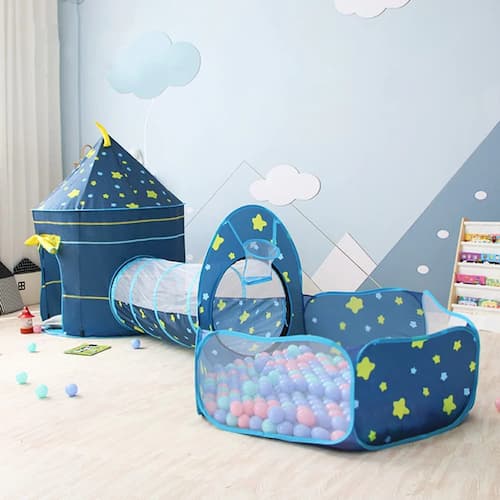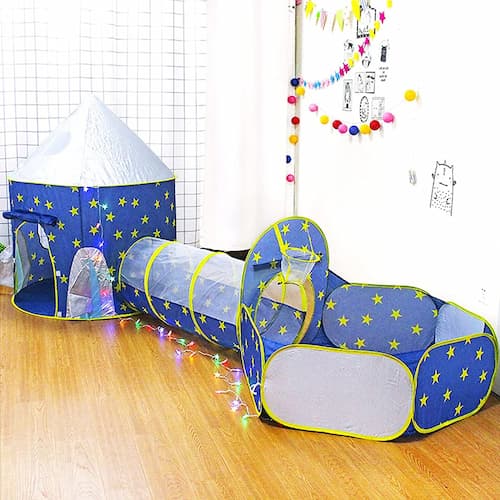Kids are full of energy and imagination, and providing them with engaging play experiences is crucial for their development. One popular and versatile play equipment that offers both fun and learning opportunities is the kid's tunnel. Whether used indoors or outdoors, kids' tunnels encourage physical activity, imaginative play, and social interaction. In this article, we will explore the benefits of kids tunnel and provide tips on creating a safe and exciting play environment for children.

Types of Kids Tunnels
There are several types of children's tunnels available, each offering unique features and play experiences. Here are some common types of children's tunnels:
1. Crawl Tunnels:
These tunnels are low to the ground, designed for young children who are just starting to crawl or walk. They typically have a wide opening and a short length, allowing easy access and exploration.
2. Pop-Up Tunnels:
These tunnels are made from flexible materials and have a spring-like frame that allows them to quickly pop open for play and fold compactly for storage. Pop-up tunnels are lightweight and portable, making them suitable for indoor and outdoor use.
3. Playhouse Tunnels:
These tunnels are designed to be part of a larger playhouse or playset structure. They often connect multiple play elements, such as slides, climbing walls, or ball pits, creating an interactive play experience.
Benefits of Kids Tunnels
1. Physical Development:
Kids' tunnels offer opportunities for crawling, climbing, and navigating obstacles, promoting gross motor skills and coordination. The tunnel's design challenges children to explore their body movements and develop strength, balance, and spatial awareness.
2. Sensory Stimulation:
Many kid's tunnels feature vibrant colors, different textures, and interactive elements. These sensory experiences stimulate children's senses, enhancing their cognitive development, creativity, and problem-solving skills.
3. Imaginative Play:
Kids' tunnels serve as portals to new worlds, inspiring imaginative play scenarios. Children can transform the tunnel into a secret hideout, a spaceship, or a magical cave, encouraging storytelling, role-playing, and cooperative play among peers.
4. Social Interaction:
Tunnels create opportunities for children to interact, collaborate, and communicate with their peers. They can engage in games of hide-and-seek, chase, or pretend adventures, fostering social skills, empathy, and teamwork.

Creating a Safe Play Environment
1. Age-Appropriate Design:
When choosing a kid's tunnel, consider the age range it is suitable for. Younger children might require shorter, wider tunnels with gentle slopes, while older kids can handle longer, narrower tunnels with more challenging features. Always follow the manufacturer's recommendations for age appropriateness.
2. Sturdy Construction:
Ensure that the tunnel is made from durable materials that can withstand vigorous play. Check for sturdy frames, reinforced seams, and non-toxic finishes. Regularly inspect the tunnel for any signs of wear and tear, and promptly address any issues to maintain safety.
3. Soft Landing Surface:
If using a tunnel outdoors, place it on a soft surface such as grass or rubber matting to cushion falls. For indoor use, consider using foam mats or carpeting. This helps reduce the risk of injuries and provides a comfortable play area.
4. Adequate Supervision:
Adult supervision is essential to ensure children's safety while using the kid's tunnel. While tunnels can provide hours of independent play, adults should be nearby to monitor the play session, intervene if necessary, and ensure that safety rules are followed.
5. Clear Play Area:
Create a designated play area for the tunnel, free from obstacles and hazards. Remove sharp objects, furniture with sharp edges, and any other potential dangers from the surrounding area. This allows children to play freely without the risk of accidents.
6. Teach Safety Rules:
Educate children about essential safety rules when using the kids' tunnel. Emphasize the importance of taking turns, crawling instead of standing, and not climbing on the outside of the tunnel. Encourage them to be aware of their surroundings and respect others' personal space during play.
Conclusion
Kids tunnels offer a wealth of benefits for children's physical, cognitive, and social development. By providing a safe and engaging play environment, we can maximize these benefits and ensure that children have a blast while staying protected. Remember to choose an age-appropriate tunnel, inspect it regularly for any damages, and supervise children during play. With proper precautions in place, kids tunnels can become a beloved playtime feature that sparks creativity, encourages active play, and fosters lasting memories for our little adventurers.












